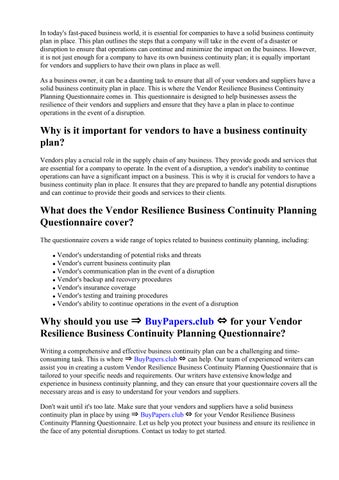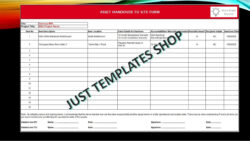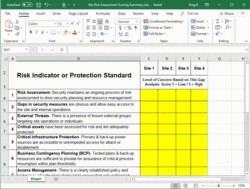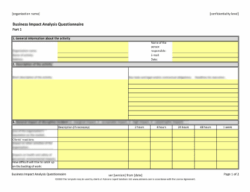In today’s interconnected business world, relying on external vendors is more common than ever. From cloud service providers to logistics partners, these relationships are vital for your operations. However, this reliance also introduces a layer of risk. If a key vendor experiences a disruption – whether it’s a natural disaster, a cyberattack, or a supply chain hiccup – your own business continuity could be severely threatened. Proactively understanding and mitigating these risks isn’t just good practice; it’s essential for survival.

That’s where a robust vendor survey template for business continuity planning comes into play. It’s not just about ticking boxes; it’s about gaining a comprehensive insight into your critical suppliers’ resilience strategies. By systematically gathering information on their preparedness, you can identify potential weak points, assess the impact on your own operations, and collaborate on solutions to build a more resilient ecosystem. It’s a proactive step that transforms potential vulnerabilities into opportunities for stronger, more secure partnerships.
Why a Vendor Survey is Crucial for Business Resilience
Your business’s ability to withstand and recover from disruptive events is directly tied to the resilience of your entire supply chain. Many organizations focus heavily on their internal business continuity plans, which is commendable, but often overlook the critical role external vendors play. A single point of failure in a third-party service can cascade into significant operational downtime, financial losses, and reputational damage for your own company. Without a clear understanding of your vendors’ preparedness, you’re essentially operating with a blind spot.
A well-designed vendor survey acts as your eyes and ears into this crucial aspect of your extended enterprise. It allows you to systematically collect data on how your vendors manage their own risks, ensuring they have adequate safeguards in place to continue providing their services even when facing challenges. This isn’t about micromanaging; it’s about ensuring alignment in your shared commitment to operational stability. The insights gained help you prioritize which vendors pose the highest risk and where deeper engagement might be necessary.
Furthermore, these surveys provide the necessary documentation for compliance and regulatory requirements. Many industries now mandate that businesses demonstrate due diligence in assessing the resilience of their third-party relationships. A comprehensive survey process ensures you can readily provide evidence of your efforts to manage vendor risk, satisfying auditors and stakeholders alike.
Key Areas to Cover in Your Survey
When developing your survey, think broadly about the potential points of failure and what information you need to assess your vendor’s readiness. It’s important to ask targeted questions that elicit actionable responses, rather than vague assurances. Focus on operational specifics and verifiable processes.
- Emergency Contact Information: Ensure you have up-to-date contacts for their business continuity and incident response teams.
- Business Continuity Plan Status: Do they have a formal, tested, and regularly updated BCP? When was it last reviewed?
- Disaster Recovery Capabilities: What are their data backup and recovery strategies? What are their Recovery Time Objectives (RTO) and Recovery Point Objectives (RPO)?
- Operational Redundancy: Do they have alternative facilities, equipment, or staff in case their primary resources are unavailable?
- Supply Chain Dependencies: Do they have their own critical sub-vendors, and how do they manage their continuity?
- Communication Protocols: How will they inform you in case of a disruption? What are their escalation procedures?
- Security Measures: What cybersecurity protocols are in place to protect your data and their systems?
By delving into these specific areas, you can build a clearer picture of your vendor’s resilience, moving beyond generic assurances to concrete details that inform your own business continuity planning.
Crafting and Implementing Your Effective Vendor Survey
Developing the survey itself is just the first step; effective implementation is where the real value lies. Start by clearly defining your objectives. Are you looking to identify all critical vendors, or just those related to a specific process? What level of detail do you need? This clarity will help you design questions that are relevant and not overly burdensome for your vendors to complete. Consider using a standardized format for ease of comparison across multiple responses. Think about incorporating a scoring system to help quantify risk and prioritize follow-up actions.
Once your template is ready, the next step is distribution. It’s crucial to communicate the purpose of the survey clearly to your vendors. Explain that it’s part of a mutual effort to ensure ongoing service delivery and strengthen your partnership, rather than just an audit. Provide a reasonable deadline for completion and offer a point of contact for any questions they might have. A cooperative approach often yields more thorough and accurate responses. Remember, this is a collaborative effort to build resilience together.
After receiving the completed surveys, the real analytical work begins. Don’t just file them away! Review each response carefully, looking for gaps, inconsistencies, or areas where the vendor’s plans don’t align with your own risk tolerance. Compare responses across different vendors providing similar services to identify potential single points of failure. This analysis will form the basis for your risk assessment and subsequent action plans. It’s about translating raw data into actionable insights that can inform your overall business continuity strategy.
Finally, the process shouldn’t be a one-time event. Vendor landscapes and internal business needs are constantly evolving. Schedule regular reviews and updates of your vendor survey template for business continuity planning, perhaps annually or whenever there are significant changes to your vendor relationships or their services. Follow up on identified weaknesses with vendors, offering to collaborate on solutions where appropriate. Building resilient partnerships is an ongoing commitment, ensuring that your business can navigate disruptions with confidence and minimal impact.
Proactively managing the continuity of your vendor relationships is no longer an option but a strategic imperative. By systematically surveying your critical suppliers, you not only gain invaluable insights into their preparedness but also foster stronger, more transparent partnerships built on shared understanding and mutual resilience. This diligent approach helps minimize the ripple effect of external disruptions, safeguarding your operations and reputation.
Embracing a robust vendor continuity program, anchored by a well-structured survey, transforms potential vulnerabilities into sources of strength. It ensures that your business is not just planning for its own survival, but for a future where its entire ecosystem is robust enough to withstand the unexpected, allowing you to focus on growth and innovation with greater peace of mind.



